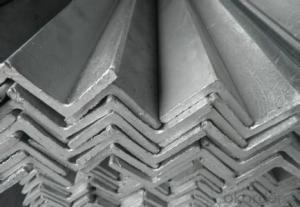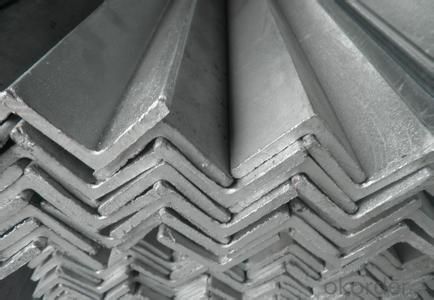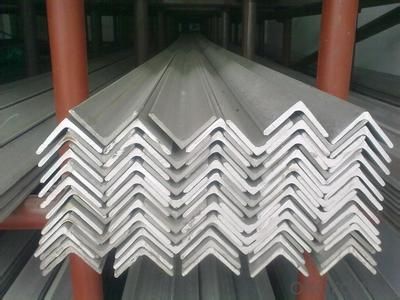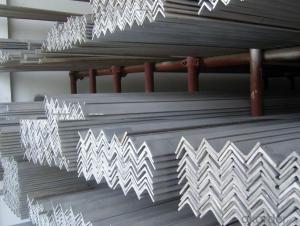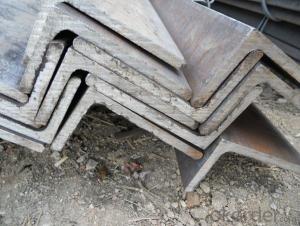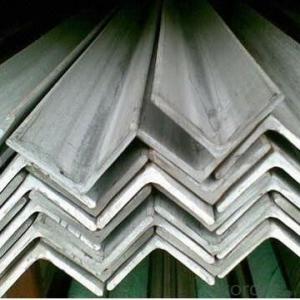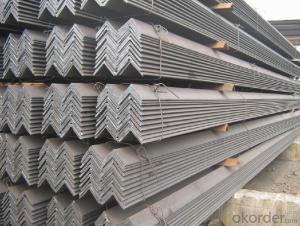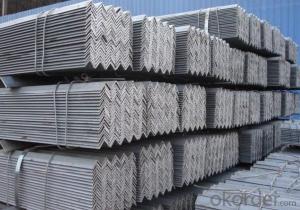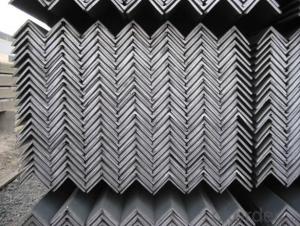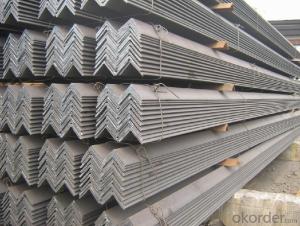high quality unequal angle ASTM A36
- Loading Port:
- China Main Port
- Payment Terms:
- TT OR LC
- Min Order Qty:
- -
- Supply Capability:
- -
OKorder Service Pledge
OKorder Financial Service
You Might Also Like
Product Description:
Stainless Steel Angles
1.Grade: SS200,300,400 series
2.Size: 25×25×3 mm-100×100×10mm
3.Process: HRAP
4. Length: 2-6m
5. Shape: Equal
6. Delivery: within 20 days
7. MOQ: 1 ton
8. Certificate: ISO 9001:2008, SGS
9. Package:Standard Export Packing, or put into wooden boxes according to your
requirement
10. Application: Construction, Marine, Industry and so on
Name | Stainless Steel Angles | ||||||
Standard | ASTM A554, A312, A249, A269 and A270 | ||||||
Material Grade | 304,316,201,202, 316L,430 | ||||||
Length | 6m or as customers' request | ||||||
Tolerance | a) thickness: +/-0. 15mm | ||||||
| |||||||
b) Length:+/-4. 5mm - 0mm | |||||||
Surface | 180G, 320G, 400G Satin / Hairline(Matt Finish, Brush, Dull Finish) 400G, 500G, 600G or 800G Mirror finish | ||||||
Application | Decoration construction, upholstery, industry instruments | ||||||
Test | Squash test, Extended test, Water pressure test, Crystal rot test, Heat treatment, NDT | ||||||
Chemical Composition of Material |
Composition
Material | 201 | 202 | 304 | 316L | 430 | |
C | ≤0.15 | ≤0.15 | ≤0.08 | ≤0.08 | ≤0.12 | ||
Si | ≤1.00 | ≤1.00 | ≤1.00 | ≤1.00 | ≤1.00 | ||
Mn | 5.5-7.5 | 7.5-10 | ≤2.00 | ≤2.00 | ≤1.00 | ||
P | ≤0.06 | ≤0.06 | ≤0.045 | ≤0.045 | ≤0.040 | ||
S | ≤0.03 | ≤0.03 | ≤0.030 | ≤0.030 | ≤0.030 | ||
Cr | 16-18 | 17-19 | 18-20 | 16-18 | 16-18 | ||
Ni | 3.5-5.5 | 4-6 | 8-10.5 | 10-14 |
| ||
Mo |
|
|
| 2.0-3.0 |
| ||
Mechanical Property | Material Item | 201 | 202 | 304 | 316L | ||
Tensile Strength | ≥535 | ≥520 | ≥520 | ≥520 | |||
Yield Strength | ≥245 | ≥205 | ≥205 | ≥205 | |||
Extension | ≥30% | ≥30% | ≥35% | ≥35% | |||
Hardness (HV) | <253 | <253 | <200 | <200 | |||
- Q: Can steel angles be used in outdoor or exposed environments?
- Yes, steel angles can be used in outdoor or exposed environments. Steel angles are often made of galvanized steel, which is coated with a protective layer of zinc to prevent rusting. This makes them highly resistant to corrosion and suitable for outdoor applications. Additionally, steel angles are known for their strength and durability, making them a reliable choice for various outdoor structures, such as fences, railings, and supports. However, it is important to note that regular maintenance and inspection may be required to ensure the ongoing integrity and performance of steel angles in outdoor or exposed environments.
- Q: What is the typical yield stress of steel angles?
- The typical yield stress of steel angles can vary depending on the specific grade and thickness of the angle, but it generally falls within the range of 36,000 to 50,000 pounds per square inch (psi).
- Q: Can steel angles be used for framing purposes?
- Yes, steel angles can be used for framing purposes. They are commonly used in construction for providing structural support and stability in framing applications, such as in the construction of buildings, bridges, and other structures. Steel angles offer strength and durability, making them an ideal choice for framing purposes.
- Q: What is the maximum temperature steel angles can withstand?
- The maximum temperature that steel angles can withstand depends on the specific grade of steel being used. Generally, carbon steel can withstand temperatures up to around 1000°C (1832°F) before it starts to lose its structural integrity. However, other factors such as the duration of exposure to high temperatures, the load applied, and the cooling rate after exposure also play a role in determining the maximum temperature that steel angles can withstand. It is always recommended to consult the manufacturer's specifications or a structural engineer to ensure that the steel angles are used within their safe temperature limits.
- Q: Can steel angles be used for transmission towers?
- Yes, steel angles can be used for transmission towers. Steel angles provide structural strength and support, making them suitable for constructing transmission towers that need to withstand various weather conditions and carry heavy loads.
- Q: How do you prevent steel angles from rusting?
- There are multiple techniques for preventing the rusting of steel angles: 1. Utilizing Protective Coatings: Applying protective coatings on the surface of steel angles proves to be an effective method in preventing rust formation. Common options for coatings include paint, epoxy, enamel, and galvanized coatings. These coatings serve as a barrier, obstructing the access of moisture and oxygen to the steel surface, thus minimizing the likelihood of rusting. 2. Implementing Rust Inhibitors: Rust inhibitors, which are chemical compounds, can be employed on steel angles to prevent rust formation. These inhibitors work by either creating a protective layer on the steel surface or actively hindering the corrosion process. Rust inhibitors can be administered as sprays, coatings, or even incorporated during the manufacturing process of the steel. 3. Ensuring Proper Storage and Handling: An uncomplicated approach to prevent rust is by appropriately storing and handling steel angles. This entails keeping them in a dry environment, preferably indoors or under some form of protective covering, to avoid exposure to moisture and humidity. Additionally, handling steel angles with clean, dry gloves can prevent the transfer of moisture from hands, which accelerates the rusting process. 4. Regular Maintenance: Regular inspection and maintenance of steel angles aid in identifying and remedying any indications of rust formation at an early stage. Timely removal of any rust spots using wire brushes or sandpaper, followed by the application of touch-up coatings, can deter further corrosion. 5. Dry Storage and Adequate Ventilation: When storing steel angles outdoors, it is crucial to ensure they are placed in a well-ventilated area to promote air circulation and prevent the accumulation of moisture. Additionally, covering the angles with a waterproof tarp or plastic wrap provides an additional layer of protection against rain, snow, and other weather elements. By employing a combination of these preventive measures, steel angles can be safeguarded against rust formation, ensuring their durability and structural integrity.
- Q: What is the typical thickness of the base of a steel angle?
- The base thickness of a steel angle can vary depending on its specific application and requirements. Typically, the base thickness of a steel angle ranges from 1/8 inch to 3/8 inch. It is worth mentioning that this range is not comprehensive, and there may be instances where the base thickness deviates from these parameters. Elements such as the steel angle's size, load-bearing capacity, and intended purpose will impact the necessary base thickness for a particular project or structure. As a result, consulting engineering specifications or seeking professional guidance is crucial in determining the suitable base thickness for a steel angle in a specific application.
- Q: How do steel angles contribute to energy-efficient construction?
- Steel angles contribute to energy-efficient construction in several ways. First, they provide structural support, ensuring that the building is strong and stable. This allows for the effective use of insulation materials, reducing heat loss or gain through walls and floors. Additionally, steel angles can be used to create efficient framing systems, minimizing thermal bridges and enhancing the building's overall energy performance. Furthermore, steel is a durable material that requires minimal maintenance, reducing the energy and resources needed for repairs and replacements. Overall, steel angles play a crucial role in energy-efficient construction by optimizing insulation, reducing thermal bridging, and enhancing the overall sustainability of the building.
- Q: Can steel angles be used for window frames?
- Yes, steel angles can be used for window frames. Steel angles provide stability, strength, and durability, making them a suitable choice for supporting and framing windows.
- Q: How do steel angles contribute to the overall earthquake resistance of a structure?
- Several ways contribute to the overall earthquake resistance of a structure by steel angles. Firstly, steel angles are commonly utilized as reinforcement elements in the construction industry. When installed and anchored properly, they can enhance the strength and stability of a structure, making it more resistant to the lateral forces generated during an earthquake. Moreover, steel angles are often employed in the creation of moment-resisting frames. These frames, composed of interconnected steel angles, are designed to absorb and distribute seismic energy throughout the structure. By distributing the seismic load, steel angles help prevent concentrated stress points and potential structural failures. Furthermore, steel angles can be strategically positioned at key locations, such as corners, junctions, and openings, to enhance the overall stiffness and rigidity of the structure. This increased stiffness assists in reducing the building's response to seismic vibrations and prevents excessive deformations that may lead to structural damage. Additionally, steel angles enable the creation of diagonal bracing systems, which are crucial for mitigating the effects of seismic forces. These systems consist of interconnected steel angles placed diagonally within the structure, forming a network that improves the building's ability to withstand lateral loads. Diagonal bracing effectively dissipates earthquake energy and redirects it away from critical components, thus enhancing the overall earthquake resistance of the structure. In conclusion, steel angles play a vital role in enhancing the earthquake resistance of a structure. They provide reinforcement, create moment-resisting frames, increase stiffness, and allow for the installation of diagonal bracing systems, all of which contribute to the structural integrity and resilience of a building during seismic events.
Send your message to us
high quality unequal angle ASTM A36
- Loading Port:
- China Main Port
- Payment Terms:
- TT OR LC
- Min Order Qty:
- -
- Supply Capability:
- -
OKorder Service Pledge
OKorder Financial Service
Similar products
Hot products
Hot Searches
Related keywords
